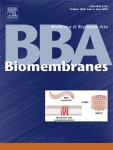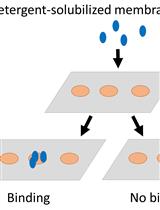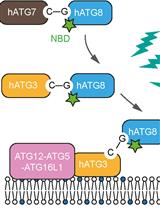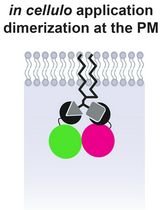- EN - English
- CN - 中文
Examination of the Interaction between a Membrane Active Peptide and Artificial Bilayers by Dual Polarisation Interferometry
采用双偏振干涉法检测膜活性肽与人造双分子层之间的相互作用
发布: 2017年01月05日第7卷第1期 DOI: 10.21769/BioProtoc.2087 浏览次数: 8124
评审: Marc-Antoine SaniFilipa Vaz
Abstract
Examining the interaction of peptides with lipid bilayers to determine binding kinetics is often performed using surface plasmon resonance (SPR). Here we describe the technique of dual polarisation interferometry (DPI) that provides not only information on the kinetics of the peptide binding to the bilayer, but also how the peptide affects the lipid order of the bilayer.
Keywords: Membrane interaction (膜相互作用)Background
The search for and development of new drugs to effectively treat resistant infections is a serious challenge. One group of molecules, the antimicrobial peptides, shows promise as effective new therapeutics due to their range of activity against bacterial, fungal and cancer cells (Mader and Hoskin, 2006; van der Weerden et al., 2013). The cell killing ability of antimicrobial peptides often involves interaction with the membrane (Brogden, 2005; Zasloff, 2002). To develop these peptides as effective therapeutics we need to understand the nature of the interaction of the peptide with the cell membrane and why this interaction results in cell death. That is, we need to know the full sequence of events that occurs between the peptide and the membrane in real time; from the initial electrostatic interaction of the peptide with the bilayer, to phospholipid selectivity, to final disruption of the membrane including changes in lipid order.
Most techniques that examine peptide-lipid interactions have a limited capacity to provide information on the entire process. For example, surface plasmon resonance (SPR) provides binding data in real time but does not reveal how peptide binding affects membrane structure (Green et al., 2000; Mozsolits and Aguilar, 2002). Other techniques such as quartz crystal microbalance (QCM) and atomic force microscopy (AFM) provide very little time resolved data as they provide information on the overall state of the system. In contrast, dual polarisation interferometry (DPI) provides real-time changes and enables quantification of the thickness, mass/density and birefringence of the membrane during peptide binding. Birefringence quantifies the degree of alignment and uniaxial packing of the lipid molecules. The changes in birefringence that occur relative to the amount of peptide bound provide information on the rate that membrane order changes, which is not available with other techniques. DPI provides unique insights into the mechanism of peptide binding, including how the peptide destabilizes the membrane, by following the dynamic changes that occur in real time as peptide binding disrupts the packing of the lipids.
This method describes DPI measurements used to examine the interaction between peptides and lipid bilayers using the Analight BIO200 (Farfield Group Ltd, Manchester, UK). The interaction between the bilayer and the interacting peptide occurs on a dual slab waveguide sensor chip that is illuminated with two alternating polarized laser beams (He-Ne, wavelength 632.8 nm). The sensor chip has four layers of silicon oxynitride deposited on a silicon wafer surface with an upper sensing waveguide that supports the lipid bilayer, and a lower optical reference waveguide. Two orthogonal polarizations are passed through the sensor chip creating two different waveguide modes; the transverse electric (TE) and transverse magnetic (TM). Both of these modes generate a field spanning from the top sensing waveguide surface to the materials coming into contact with the sensor surface. The molecules that make contact with the surface change the refractive index. When this occurs, the phase difference between the sensing waveguide and the buried reference waveguide is altered and the position of the interference fringes changes. This interference fringe pattern for both the TE and TM illuminates a 1,024 x 1,024 element-imaging device and the data from this is transferred to the digital signaling processing unit. Data is collected every 2 milliseconds using a spatial Fourier transform method and is transferred to the computer for real time data display and further analysis of the data to reveal thickness, RI and birefringence values.
Materials and Reagents
Note: All solutions must be degassed prior to running on the DPI machine.
- Liposome preparation
- Round-bottom glass vials such as Kimble culture tubes 20 mm diameter, 125 mm length with screw caps (Kimble, catalog number: 73770-20125 )
- Parafilm
- Polycarbonate membrane; 19 mm diameter, 100 nm pore diameter (Sigma-Aldrich, catalog number: Z377419 )
- Syringes (50 ml for running buffer, 3 ml for sample loading)
- Wide gauge needle
- Lipids
- L-α-phosphatidylinositol (PI, bovine liver) (Avanti Polar Lipids, catalog number: 840042P )
- L-α-phosphatidylinositol-4,5-bisphosphate (PI[4,5]P2, porcine brain) (Avanti Polar Lipids, catalog number: 840046X )
- 1-palmitoyl-2-oleoyl-sn-glycero-3-phosphoethanolamine (POPE) (Avanti Polar Lipids, catalog number: 850757P )
- 1-palmitoyl-2-oleoyl-sn-glycero-3-phosphocholine (POPC) (Avanti Polar Lipids, catalog number: 850457P )
- 1-palmitoyl-2-oleoyl-sn-glycero-3-phosphoserine (POPS) (Avanti Polar Lipids, catalog number: 840034P )
- Chloroform (VWR, catalog number: 22707.320 )
- Methanol (Sigma-Aldrich, catalog number: 494291 )
- MilliQ water
- N2 gas
- MOPS (3-morpholinopropane-1-sulfonic acid) buffer (Sigma-Aldrich, catalog number: M1254 )
- Sodium chloride (NaCl) (Sigma-Aldrich, catalog number: 793566 )
- Round-bottom glass vials such as Kimble culture tubes 20 mm diameter, 125 mm length with screw caps (Kimble, catalog number: 73770-20125 )
- Dual polarization interferometry
- 10% Hellamanex II (Hellma, Müllhein, Germany)
- Sodium dodecyl sulfate (SDS) (Sigma-Aldrich, catalog number: 74255 )
- 100% ethanol
- Calcium chloride (CaCl2) (Sigma-Aldrich, catalog number: 746495 ) (see Recipes)
- Membrane interacting protein (for example NaD1)
- Ethylenediaminetetraacetic acid (EDTA) (Sigma-Aldrich, catalog number: EDS ) (see Recipes)
- Bovine serum albumin (BSA), fraction V, fatty acid free (Sigma-Aldrich, catalog number: 10775835001 )
- MilliQ water
- Sodium hydroxide (NaOH) (Sigma-Aldrich, catalog number: S5881 )
- Bulk buffer (see Recipes)
- 2% SDS (see Recipes)
- 80% ethanol (see Recipes)
- 10% Hellamanex II (Hellma, Müllhein, Germany)
Equipment
- Liposome production
- Water bath
- Fume hood
- Vacuum pump and chamber
- Sonicator bath
- Shaking incubator
- Avestin lipofast extruder (Sigma-Aldrich, catalog number: catalog number: Z373400 )
- Water bath
- Dual polarization interferometery
- Silicone oxynitride AnaChip unmodified (Farfield Group Ltd)
- Gasket two-channel (Farfield Group Ltd)
- Analight® Bio200 DPI instrument (Farfield Group Ltd, UK)
- Harvard Apparatus PHD2000 programmable syringe pumps
- Silicone oxynitride AnaChip unmodified (Farfield Group Ltd)
Software
- Analight Explorer software
Procedure
文章信息
版权信息
© 2017 The Authors; exclusive licensee Bio-protocol LLC.
如何引用
Payne, J. A., Lee, T., Anderson, M. A. and Aguilar, M. (2017). Examination of the Interaction between a Membrane Active Peptide and Artificial Bilayers by Dual Polarisation Interferometry. Bio-protocol 7(1): e2087. DOI: 10.21769/BioProtoc.2087.
分类
生物化学 > 脂质 > 脂质-蛋白互作
您对这篇实验方法有问题吗?
在此处发布您的问题,我们将邀请本文作者来回答。同时,我们会将您的问题发布到Bio-protocol Exchange,以便寻求社区成员的帮助。
Share
Bluesky
X
Copy link

















